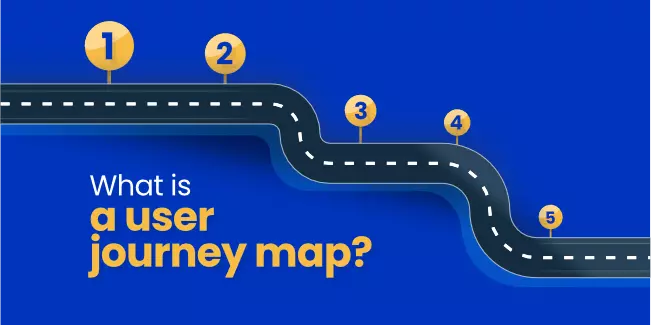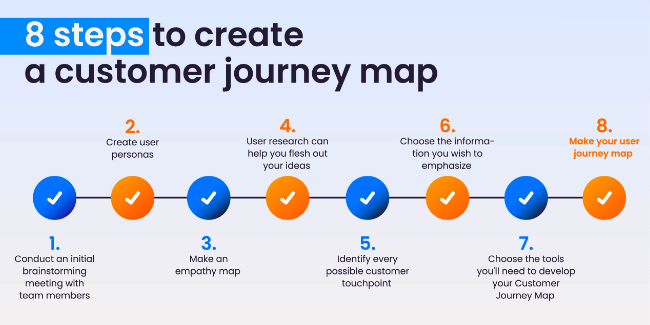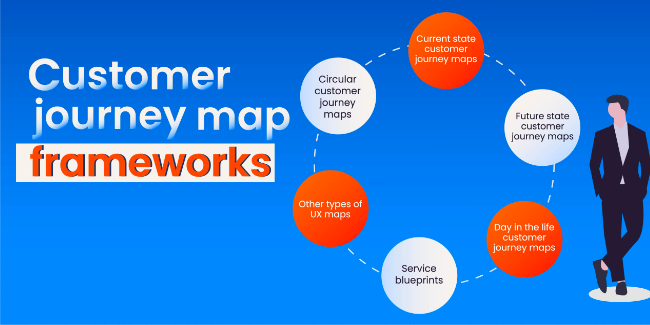ux/ui
journeymap
customerjourney
What is a user journey map?

A customer journey map visually represents a customer's experience with your company. These visuals tell how a client progresses through each stage in the process and feels each step of the way. Touchpoints and moments of truth should be included in your customer journey map, potential consumer emotions such as dissatisfaction or confusion, and any actions you want the customer to take.
When talking about a customer journey map, it is not difficult to ignore the subject of the product roadmap. This is another element of development strategy planning that is worth getting to know. This is why we have created the article "Product Roadmap - how to write user stories and user flows?" which is part of our Discovery Workshop.
Customer journey maps are frequently based on a timeline of activities, such as a customer's initial visit to your website and the method they progress toward their first in-product experience, then purchase, onboarding emails, etc.
However, while it may be necessary to tailor your customer journey maps to your company or product, the most effective approach is to interact with consumers (conduct research). Study your target audiences to discover how they make decisions, choose to buy things, etc. A customer map will not help you succeed if you don't fully know your consumers' requirements. But, a well-designed and researched customer journey map may provide you with valuable insights into your company's customer experience.
Why do you need a customer journey map?
One of the most important reasons organizations employ customer journey maps is to understand better how their customers use their products. Mapping out customer journeys can help you determine why consumers make their decisions and which part of your offering is essential to them.
One of the most important aspects is product discovery. What is this process and why is it important for your project? You will find out in our article "What is the Product Discovery and Product Discovery Process?" Be sure to check it out and learn more about the proper development of your product!
Customer journey mapping can also assist you in determining how and when to make improvements to your product. It can help you better understand which modifications will be advantageous to them by helping you pinpoint one of the essential phases or features that are essential to a customer.
Use a customer journey map template to understand better how various personas utilize your product by drilling down. You may develop varied pathways for different personalities and provide a more personal experience due to this knowledge.
A user journey map template may help you identify the points in the trip when your consumers require the most assistance. You can then focus your customer support efforts on those parts.
Empathy and a thorough knowledge of customer requirements and problems are required for effective, long-term client connections. Creating a shared understanding of your customers' thoughts, feelings, and difficulties while interacting with your brand is necessary for developing a customer journey map. A customer journey map may assist your entire organization in aligning around resolving known issues, identifying new user pain spots, and removing roadblocks to your clients' (and, therefore, your company's) success.
Benefits
- Visualize how a customer interacts with your product, from start to finish.
- Understand how customers interact with your business through a variety of points of contact, including email and phone (experience maps)
- Increase empathy for current and future clients. You will be know how to be in a customer's shoes.
- You'll be able to communicate more effectively with the intended audiences (customer persona), and you'll be better positioned to solve problems.
- Uncover and prioritize existing pain points and roadblocks and identify gaps.
- Improve internal alignment.
- Build a shared vision for your product.
- Help cross-functional teams (marketing, sales, development team, and other team members) understand customers' feel.
- Developing a personalized experience for each customer is crucial to retaining them once they've made the purchase. Using channel optimization, you can increase customer engagement.
- Identify and optimize moments of truth in the customer experiences.
- Improve the efficiency of existing touchpoints.
- Change your view from a business to a client-focused viewpoint.
- Create a unified view of your organization. Break down departmental silos and close interdepartmental gaps.
- Develop and implement marketing campaigns to cater to the needs of specific customer personas.
- Recognize the circumstances that might have caused anomalies in previously collected numerical data.
Customer journey mapping is a must for any company, but not every company's map will be the same. For example, an e-commerce map will appear different from a UX designer's B2B SaaS users' map.
Process of creating a user journey map
Regardless of the sort of customer journey map you choose to generate, the overall process will be similar at a high level.
In brief, here are the 8 steps to creating a customer journey map

- Conduct an initial brainstorming meeting with team members.
- Create user personas (customer persona is a fictional character representing your average customer based on user and market research.)
- Make an empathy map.
- User research can help you flesh out your ideas.
- Identify every possible customer touchpoint.
- Choose the information you wish to emphasize.
- Choose the tools you'll need to develop your Customer Journey Map.
- Make your user journey map.
Now that you know what to expect let's begin your visualization. Customer journey maps can get complicated if you don't keep them simple. Even though you may investigate and visualize the viewpoints of numerous personas, pick just one persona and one customer scenario at a time.
1. Set goals
It will be challenging to determine whether your customer journey map translates into a real difference for your customers and company if you don't have a goal. You'll almost certainly need to identify existing—and future buyers to set objectives specific to those audiences at each stage of their experience.
Cross-functional cooperation is critical for establishing a logical and doable objective. To set a reasonable and achievable aim, you'll need to bring the key stakeholders from your company together. Collect different viewpoints and insights on each stage of the current customer journey, where improvements are required, and how they will be measured.
2. Conduct persona research
Use this section to flesh out as much information as possible about the persona your customer journey map is based on. Depending on the maturity of your company, you may only have a few records, reports, or other pre-existing data regarding the target persona. You may begin by compiling your first findings to create a hypothesis of the consumer journey.
However, the most helpful information you can get is from real consumers or customer interactions —those who have used your brand and had an experience with it. In any of the following manners, gather valuable consumer data:
- Survey customers. User interviews will help you with understanding customer needs.
- Talk with people from your company who deal with consumers regularly, and they know customer needs!
- Examine client feedback and complaints. Talk about the impact of each pain point.
- Use social media to monitor discussions about your firm. It is how a user interacts with your organization.
- Use web analytics to your advantage.
- Gather Net Promoter Score (NPS) data.
Look for evidence that discusses the following topics
- How customers first discovered your brand
- When customers purchase or cancel
- How easy was it for them to get around your website
- What problems did or didn't your brand address?
Throughout your research process, collecting qualitative and quantitative data keeps your firm making data-driven judgments based on the voice of real consumers.
3. Define customer touchpoints
The majority of your customer journey map will be filled with customer touchpoints. They are how and where consumers engage with and experience your brand. The quantity and type of touchpoints on your customer journey map will differ depending on the kind of business you conduct. When you're researching and drawing up your touchpoints, keep in mind that you'll need data on the action, emotion, and potential difficulties.
After establishing your touchpoints, you may begin laying them out on your customer journey map.
4. Map the current state
Create a customer journey map documenting the existing customer experience. Prioritize substance over aesthetics when creating your as-is state of the customer journey. To assure accuracy, solicit input from the stakeholders and construct your customer journey map collaboratively.
You may have a unique style that works for you. Still, the standard format for customer journey maps includes touchpoints, activities, channels, and assigned ownership of a touchpoint (sales, customer service, marketing) at each stage. Then use images and color and shape variation to more efficiently view the various actions, emotions, transitions, and so on. You can use your current state as a starting point to examine where you're currently at and what needs to be improved. You might also notice areas for improvement or red flags in the experience.
5. Map future states
Now that you've imagined the present condition of the customer journey, your map will almost certainly reveal holes in CX, data overlap, poor transitions between stages, and significant pain areas or roadblocks for consumers. Instead of mapping the current situation, the future state map out a scenario you haven't completed yet. One that enhances existing problem areas is another option, or you may create an entirely innovative amazeballs fantastic experience.
Customer journey mapping examples by type
Every customer journey is unique. That's something you already know, but it's important to remember it. Because of this, there is no such thing as a "one-size-fits-all" customer journey map example or template. The ideal journey map for any given case will be determined not just by your clients but also by your product or service, your team, and the objectives you want to attain by developing one in the first place.
To help you find the correct format for your customer journey map, there are the most popular frameworks:

- Current state customer journey maps
- Future state customer journey maps
- Day in the life customer journey maps
- Service blueprints
- Circular customer journey maps
- Other types of UX maps (empathy map, experience map)
Customer journey map (CJM) vs. Service Blueprint (SB)
Service Blueprint is a tool used to present, analyze and plan the entire service provision process. It usually takes the form of a diagram that includes all activities at each stage of service delivery and is performed by different people.
Creating a service plan assumes the performance of an analysis of the recipient's activity and an action plan on the part of the company and its partners, and a study from the organization's point of view. The so-called user level (user actions), visible level (front-stage), as well as invisible to the user (backstage activities, support processes).
Differences SB and CJM
Service Blueprint and Customer Journey are two different tools. The overriding goal of the former is to improve the quality of the service provided. The second is to improve the customer experience.
Therefore, it is crucial to identify all the elements that affect their satisfaction with the service in the customer's path. The whole process consists in recreating all the points of contact between him and the brand and then identifying his expectations and problems, as well as gaps in the service and underdeveloped elements. All this allows us to design services that meet the needs of their users to the maximum extent possible.

On the other hand, SB allows you to look at the service from a broader perspective. The tool considers the activities undertaken by the user and attaches great importance to the organization's activities and the role of people involved in delivering a given process.
Both these tools complement each other, and the combination of both is the key to creating services at the highest level.
Conclusion
It's critical to note that building a user journey map aims to establish a common view. That's why, once you've finished one, share it with your team members. Make it possible for everyone in your team to see the whole experience from the user's perspective and incorporate this information while developing a product.